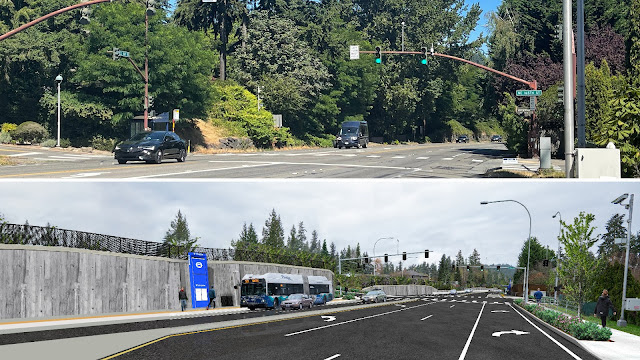Image


CORE is a group of concerned neighbors who live in LFP, sharing information about ST3 and its impacts on our community. Contact: info@lfpcore.org or see www.lfpcore.org

Lake Forest Park prides itself on its mature trees and green entry along Bothell Way, SR 522, its central transit corridor. This contributes to the city’s character as a green village.
These trees and our environment, the very identity of Lake Forest Park, are at threat.

Sound Transit plans to construct a 1.2-mile, dedicated eastbound bus lane through Lake Forest Park as part of their SR522/145th BRT (bus rapid transit) project.
This will remove 490 trees, deforesting Bothell Way in the city. Also, it will widen the road, shifting it west, cutting into the properties of 110 residents.
Tall concrete retaining walls, requiring extensive road construction, will be built to support the new steep cuts. This will destroy the character of Lake Forest Park, turning our city entry into a concrete corridor.
 |
| NE 165th Before - A green village NE 165th After - A concrete corridor |
Luckily, there is a better way and it is not too late to spare our city’s trees and environment while still achieving important regional transit goals.
We are a small community of nearly 14,000 residents. Many of us live here because we value a close relationship with nature.
Sound Transit has avoided providing community transparency, meaningful analysis, and meaningful community outreach during their design process for the SR522/145th BRT project in Lake Forest Park.
This project, currently at the 60% design stage, could have serious negative consequences on our community. We ask Sound Transit to modify the design, reducing impacts and costs.
Between 2019 and June 2020, Sound Transit dramatically changed the alignment, shifting Bothell Way to the west, and implementing the “West Shift.” This shift impacts 110 property owners and the greater Lake Forest Park Community.
Sound Transit never informed us of the magnitude of this shift or the impacts created by this “West Shift.” The “West Shift” changes the character of our community, affecting residential housing disproportionately.
Sound Transit has focused solely on creating a Business Access and Transit (BAT) lane, disregarding all other factors. Their plan does not address the concerns of our community.
Sound Transit has focused solely on creating a Business Access and Transit (BAT) lane, disregarding all other factors. Their plan does not address the concerns of our community.
Nor does it consider the most likely alternative to the BAT lane: Queue Jumps. Queue Jumps are dedicated lanes and signal priority at busy intersections that allow transit to get a head start on traffic. Sound Transit designed Queue Jumps for NE 145th Street, where Seattle prohibited BAT lanes.
We ask Sound Transit to modify the design and compare the cost and efficiency of Queue Jumps to the dedicated BAT lane. This will substantially reduce the amount of tree removals, the need for walls, property acquisitions, and overall cost. Queue jumps would achieve nearly the same transit time savings, which with the BAT build, is only 2.3 minutes during the three-hour, eastbound, afternoon rush hour.
The current plan removes 490 trees along the alignment, deforesting Bothell Way. With this expansion, the highway moves approximately 10’-12’ closer to the west side homes, removing the landscaping from 60,000 square feet of our neighbors’ backyards.
There is no plan for noise mitigation. Instead, on the west side of Bothell Way, there are concrete retaining walls, up to 16’ tall, along nearly the length of the alignment. These retaining walls create a concrete corridor that will send sound up these faces and also eastward, across the highway. On the new sidewalk next to the highway, the sound will exceed 80 decibels.
Buses will run every 10 minutes, up and down both sides of Bothell Way, totaling 220 trips daily.

Sound Transit’s SR522 Noise and Vibration Study did not sample sound along the alignment at the most impacted residential areas. In fact, the report was completed before the “West Shift.” Also, an outside agency never completed an Environmental Impact Statement, as typically required by Washington State.
Sound Transit’s plan for widening the highway on the east side of Bothell Way shows that at Bsche’tla creek, the steep banks of the creek and the buffer zones are “cleared and grubbed,” removing over 28 trees, clearing the understory, making this slide-prone area more unstable.
This construction impacts habitat and nearby businesses, requiring even more property acquisitions on the east side of Bothell Way, south of 155th Street NE.
Regarding budget, this project has the most expensive cost per mile in ST3. The price tag for ST3 ranges from $626 million to $651 million. Of the 205 total property acquisitions, 110 are in Lake Forest Park.
Sound Transit budgeted $83 million for the property acquisition costs in LFP. The overall cost for SR522 / NE 145 BRT is over $250 million, or 40% of the total ST3 budget.
We support transit.
We request a more equitable, environmentally healthy, sustainable, and contextual design that we can all be proud of when this Project is completed and it becomes our legacy for the next 100 years. The best way to achieve these goals is to modify Sound Transit’s current plan utilizing queue jumps instead of a dedicated eastbound BAT lane.
What You Can Do: